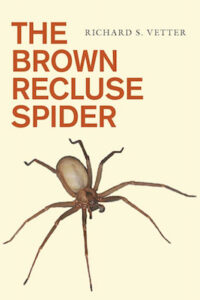Far more difficult than teaching a cat a trick or eating only one potato chip is the challenge of explaining to someone that the Brown Recluse spider he or she claimed to have recently seen was, in fact, very likely not one. There’s just something about this species that has taken hold of our imaginations; something that, despite all reason and evidence to the contrary, causes sometimes even the entomologically-savvy amongst us to see them far more often and in far more places than we know their populations or their geographic range to be.
Richard S. Vetter, however, knows better than most where Brown Recluse spiders are to be found (as well as where they are not), in what quantities localized populations have been shown to exist, how frequently they – as well as their bites – are misidentified, and just about anything else one would care to learn about this, in all honesty, relatively nondescript brown spider. It’s this abundance of not just knowledge but genuine understanding of the species that makes his book The Brown Recluse Spider such a superbly informative as well as highly enjoyable book to read.
Vetter, a staff research associate in the Urban Entomology program at the University of California, Riverside, has published numerous articles on the Brown Recluse in such important scientific journals as Journal of Medical Entomology and the New England Journal of Medicine, however this is the first book he has written for a general audience. And if there was ever a species of spider for which an authoritative book written for a general audience was most urgently needed, it would be the Brown Recluse.
As Vetter recounts, prior to 1957, the Brown Recluse, Loxosceles reclusa, was not a particularly well known species. Native to North America and primarily limited even there to the south-eastern United States, the Brown Recluse is physically rather plain and even somewhat delicate in appearance, notoriously reclusive in its habits (hence it’s name), and not particularly aggressive. It does, however, possess a venom that in about ten percent of bites (envenomations) results in “dramatic skin lesions” that often become necrotic, and that approximately one percent of the time can cause a systemic reaction that may result in death.
Notice all those qualifiers in the previous paragraph? They’re there for a reason, and it’s a reason that Vetter returns to repeatedly in The Brown Recluse Spider. For while it is indeed, along with the Black Widows, Latrodectus mactans and Latrodectus hesperus, a “medically significant” spider, its bite is not nearly as lethal or even as frequently debilitating as the popular media from the middle of the Twentieth Century right on up to today have convinced so many of us that it is.
It’s a topic to which Vetter devotes considerable attention; an entire chapter, in fact – “Human Psychology an the Brown Recluse Spider,” – examines the many reasons that this spider has become the arachnid boogey-man of our time and why it is so difficult to overcome all the incorrect information perpetually swirling around it. Another, “Medical Misdiagnoses,” explains the problems that misunderstandings by medical professionals of the Brown Recluse’s range, population density, and pathology can and have caused.
But Vetter’s The Brown Recluse Spider isn’t by any means just about public misunderstandings of these spiders; it’s a complete overview of their life history and biology as well as a guide to how to identify them accurately and how, when needed, to control populations of them. And most importantly of all, it’s written for a general audience, something an authoritative book about a single arthropod species rarely is. However lest it be thought that in writing to a general audience that information has been excessively simplified, all the scientific terminology that might be desirable for professionals – especially medical professionals, whom Vetter is particularly interested in informing about Brown Recluses – is included parenthetically wherever needed to ensure accuracy.
As a naturalist, I am – as well as many other naturalists I know are – frequently called upon to make identifications, explain phenomena, and provide other natural history related guidance on a variety of topics. To have such a clearly written and informative book as Richard S. Vetter’s The Brown Recluse Spider in my library for my own education and reference as well as in print and readily available to recommend to others interested in learning the truth about this much misunderstood and commonly misrepresented spider is both a personal joy as well as a noteworthy benefit to naturalists, as well as the simply curious, everywhere.
 Title: The Brown Recluse Spider
Title: The Brown Recluse Spider
Author: Richard S. Vetter
Publisher: Cornell University Press
Imprint: Comstock
Format: Paperback
Pages: 186 pp., 66 Illustrations, 49 halftones (color) 6 tables, 6 line drawings, & 5 charts
ISBN-10 0-8014-7985-1
ISBN-13 978-0-8014-7985-4
Publication Date: April 2015
In accordance with Federal Trade Commission 16 CFR Part 255, it is disclosed that the copy of the book read in order to produce this review was provided gratis to the reviewer by the publisher.
